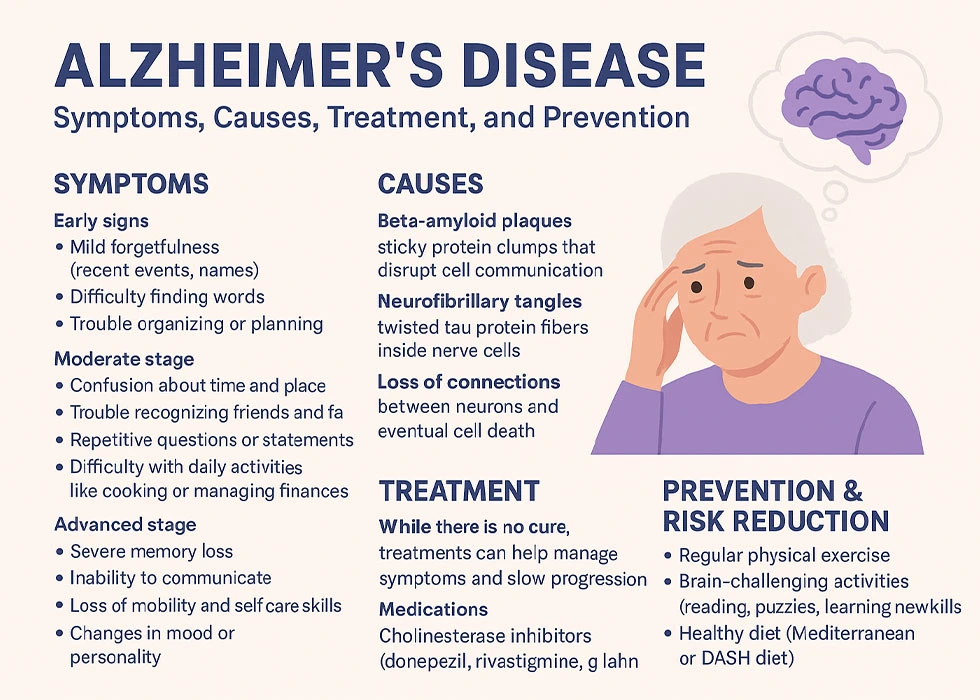
Alzheimer’s Disease: Symptoms, Causes, Treatment, and Prevention
- August 14, 2025
- 1 Like
- 40 Views
- 0 Comments
Introduction
Alzheimer’s disease is the most common cause of dementia, a progressive condition that affects memory, thinking, and behavior. It accounts for 60% to 80% of all dementia cases, most often developing in people over the age of 65, though younger onset can occur. Over time, Alzheimer’s damages brain cells, making it increasingly difficult to perform daily activities. While there is currently no cure, early diagnosis, symptom management, and lifestyle changes can help slow its progression and improve quality of life.
Understanding Alzheimer’s Disease
Alzheimer’s is a neurodegenerative disease, meaning it gradually destroys brain cells and their connections. This process begins years before symptoms appear, often starting in the hippocampus — the brain region responsible for memory. Abnormal accumulations of two proteins, amyloid and tau, form plaques and tangles inside the brain. These disrupt communication between nerve cells, eventually leading to their death.
Unlike normal age-related forgetfulness, Alzheimer’s symptoms steadily worsen and interfere with daily life. Each person’s journey is unique, with some experiencing slow changes over many years and others declining more rapidly.
Early Signs and Symptoms
In the earliest stages, symptoms may be subtle and easily mistaken for stress or normal aging. As the disease progresses, cognitive decline becomes more noticeable. Common symptoms include:
- Memory loss affecting daily activities, such as forgetting important dates, events, or familiar routes.
- Difficulty with problem-solving or planning, such as following recipes or managing bills.
- Language problems, including trouble finding words or following conversations.
- Disorientation in familiar places or confusion about time and dates.
- Poor judgment and decision-making.
- Changes in mood or personality, such as increased suspicion, anxiety, or withdrawal from social activities.
- Loss of coordination or difficulty with spatial awareness, leading to more frequent bumps, falls, or trouble with tasks like buttoning clothes.
In the later stages, individuals may struggle to walk, talk, eat, or respond to their surroundings, requiring full-time care.
Causes and Risk Factors
The exact cause of Alzheimer’s remains unclear, but scientists agree it involves a mix of genetic, lifestyle, and environmental factors. The main biological drivers are the build-up of amyloid plaques and tau tangles in the brain. These changes can start a decade or more before symptoms appear.
Key risk factors include:
- Age — risk increases significantly after 65.
- Family history and genetics, particularly the APOE ε4 gene.
- Medical conditions such as cardiovascular disease, diabetes, high blood pressure, and obesity.
- Lifestyle factors like smoking, poor diet, and low physical activity.
- History of brain injury or repeated head trauma.
- Lower educational engagement and reduced lifelong mental activity.
While some risk factors can’t be changed, others — such as heart health, diet, and mental stimulation — can be managed to lower overall risk.
Stages of Alzheimer’s Disease
Alzheimer’s is a progressive condition, generally divided into stages:
- Preclinical stage – Brain changes occur without obvious symptoms, sometimes for years.
- Mild cognitive impairment (MCI) – Memory lapses and mild difficulties with thinking or planning become noticeable but do not yet disrupt daily life.
- Mild Alzheimer’s disease – Symptoms begin to interfere with work, social life, and daily tasks.
- Moderate stage – Increased memory loss, confusion, and difficulty recognizing family or friends; possible behavioral changes.
- Severe stage – Loss of ability to communicate, recognize loved ones, or perform basic functions; requires round-the-clock care.
Diagnosis
There is no single test for Alzheimer’s disease. Doctors use a combination of methods to rule out other causes and confirm a diagnosis, including:
- Medical history review and interviews with family members or caregivers.
- Cognitive and neurological exams.
- Brain imaging, such as MRI, CT, or PET scans, to detect changes in brain structure and function.
- Blood tests and, in some cases, genetic testing.
A confirmed diagnosis allows for early intervention, which can help slow symptom progression.
Treatment and Management
Although there is no cure for Alzheimer’s, treatments can help manage symptoms and maintain independence for longer.
Medications
- Cholinesterase inhibitors (donepezil, rivastigmine, galantamine) can improve communication between brain cells and ease symptoms like memory loss and confusion.
- NMDA antagonists (memantine) can help regulate brain activity and improve function in later stages.
- Newer therapies like lecanemab and donanemab target amyloid protein build-up to slow progression.
Supportive care
- Physical therapy to maintain mobility.
- Speech therapy to improve communication skills.
- Nutritional guidance to ensure balanced diets.
- Mental health support for depression, anxiety, or caregiver stress.
Caregiver support is crucial. Alzheimer’s care often involves respite services, support groups, and long-term planning.
Living With Alzheimer’s
For patients, focusing on routines, staying socially connected, and engaging in mentally stimulating activities can help preserve abilities. For caregivers, education and self-care are essential to prevent burnout. In advanced stages, palliative or hospice care may be recommended to ensure comfort and dignity.
Prevention and Brain Health
While Alzheimer’s cannot be completely prevented, evidence suggests that maintaining overall brain health can lower risk:
- Eat a balanced diet rich in fruits, vegetables, lean proteins, and healthy fats (e.g., Mediterranean or DASH diets).
- Stay physically active with regular exercise.
- Keep your mind engaged through reading, puzzles, or learning new skills.
- Maintain strong social connections to reduce isolation.
- Manage chronic conditions like diabetes, high blood pressure, and high cholesterol.
- Avoid smoking and limit alcohol intake.
Outlook
Life expectancy after an Alzheimer’s diagnosis varies, but most people live between four and eight years, with some surviving much longer. Early detection, healthy lifestyle habits, and appropriate care can make a significant difference in maintaining quality of life.


Leave Your Comment